GRAND VINTAGE 2006 × LE&(ル・アンド)Vol.1
A new taste and experience pioneered by Moët & Chandon
1999.01.01
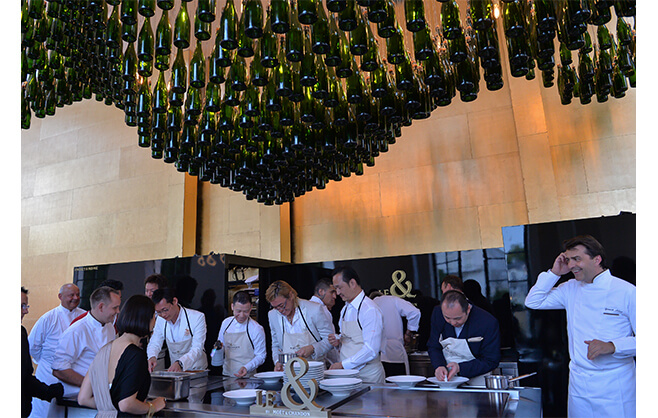
This year Moët & Chandon, one of the renowned Grandes Marques, established in 1743, who lead the champagne industry, offered a new gastronomic experience, “LE&” a collaboration between Benoît Gouez, Chef de Cave (cellar master) at Moët & Chandon, and Yannick Alléno, a chef representing the world of French cuisine. The event also became a stage to unveil their Grand Vintage 2006.

“Moët & Chandon’s” own vineyard is the most extensive and diversified among all the champagne houses. It extends across 61 villages and encompasses an area of 1,190 hectares, with 50% of that grands crus (field) and 25% being premières crus, promising high quality. The house also purchases grapes from the producers of 234 crus of the total 319 in the Champagne region, greatly varying the types of grape used in production.
The product born of these superior combinations exemplify the concepts of “freedom” and “creation.”
The secret to making a superior champagne is in the assemblage of grapes from different fields. Excellent assemblage is achieved by carefully sensing the characteristics of vineyards whose soil and climate conditions contain subtle differences, and skillfully blending together their most attractive features. ”Moët & Chandon,” boasting a wide variety of quality grapes, is in the best possible position to explore this ingenious and delectable mélange.
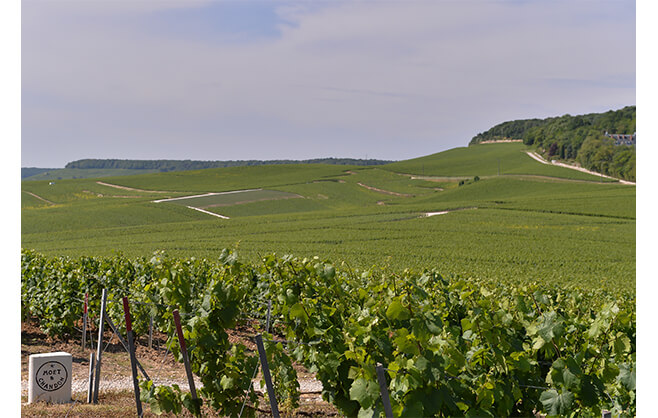
The vineyard features the largest area and variety in the Champagne region. Nearly 250 winegrowers are engaged in production throughout the year.
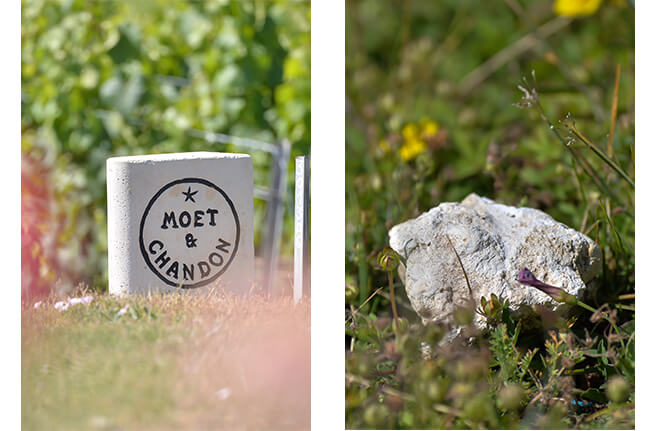
La lutte raisonnée (environment preserving-type farming) has been adopted since 2001. As 75% of the Champagne region’s soil is calcareous, a great minerality is imparted to the grapes.
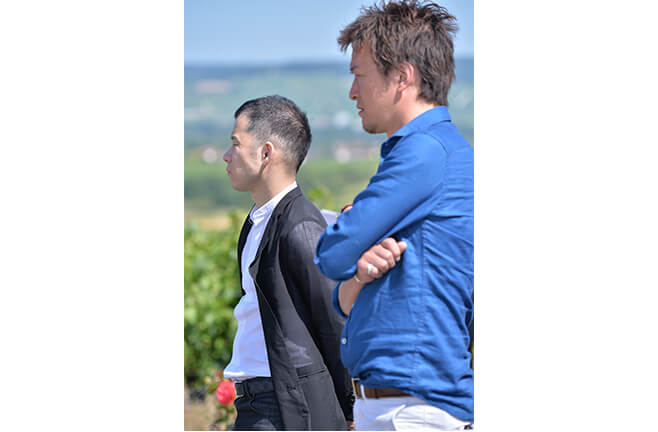
Shinichi Sato from ”Passage53“ and Hiroki Yoshitake from “Sola,” both restaurants in Paris, look over the vineyard.
A key player who has added dramatic innovation to the house’s vineyard is Chef de Cave Benoît Gouez. He provided impetus to the evolution of vintage champagne from “something made from excellent grapes harvested at their peak” to “something that expresses the uniqueness by highlighting more the character of the year.”
After the millesime (vintage champagne) in 2000, the name of Moët & Chandon vintage champagne hanged from “Vintage” to “Grand Vintage” with the aim of encouraging winemaking that expresses a more free-form and creative style. Then the house has introduced remarkable vintages such as the 2000 that emphasizes the character of the Chardonnay, releasing the 2002 after a longer-than-usual 7-year ripening period, and the 2003 for which Benoit famously took advantage of the blistering heatwave.
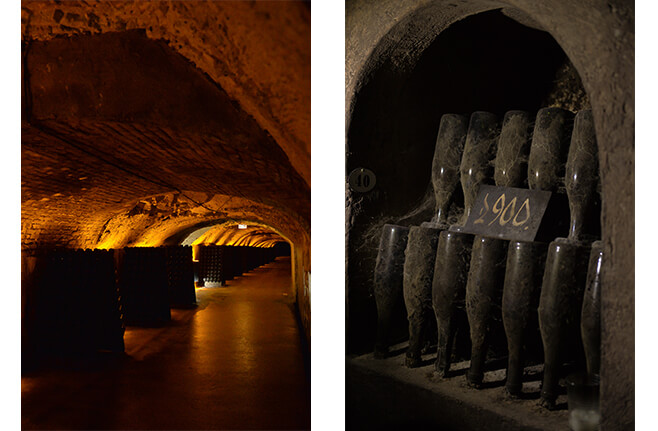
Wine caves are also known as “second vineyards.” The caves, like the vineyards, are also on a grand scale. Bottles sorted by year or cuvee silently age.
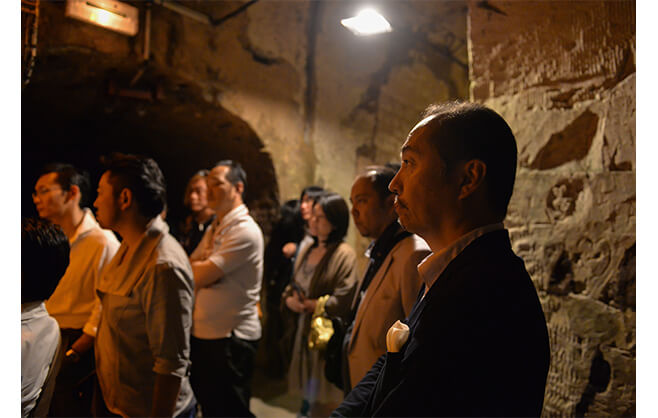
There is a secret door to which only the Chef de Cave has the key, and historic vintages after 1892 are carefully guarded behind it. Shinya Tasaki gazed at the collection with great interest.
This year Moët & Chandon has released the Grand Vintage 2006, which is characterized by a rich taste, spacious flavor and a floral scent. Benoît’s champagne-making has always brought with it a fresh surprise by displaying a true creativity, taking advantage of the flexibility afforded by an extensive and diversified vineyard.
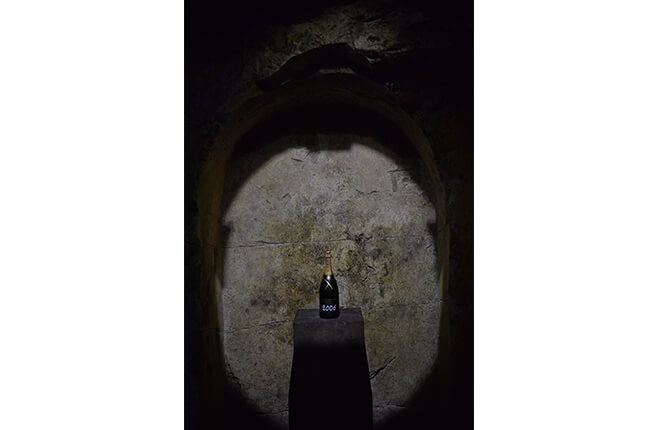
As Moët & Chandon’s Grand Vintage champagne is made only with that year’s grapes, if the year is blessed with great weather and excellent field conditions, the full flavor can be savored. Moreover, the Chef de Cave assesses the quality of the year’s grapes, adding a hint of free thinking and artistry into the mix. The first Moët & Chandon vintage champagne was produced in 1842. From that time until 2006, 71 vintage champagnes have come into being. Producing only 71 vintage champagnes over a period of time of 172 years reveals the true nature of champagne-making: a significant challenge and constant battle with nature.
Benoît pioneered a new approach to further enhance the sensuality inherent in champagne. This is “LE&” a feast providing a new taste experience through a collaboration with Yannick Alléno, a chef representing the world of French cuisine.
Thousands of wine and food combinations exist, yet the point of “LE&” is a bit different from a simple pairing. He states, “This is an opportunity to enjoy the fascination of champagne from various perspectives through Yannick’s innovative but simple cuisine and to experience a feeling akin to taking a long journey.
“L’Orangerie,” a mansion in front of Moët & Chandon headquarters, is the official guest palace. This legendary estate, once used to welcome NapoleonⅠ, became the stage of “LE&” It was then opened to the public after special renovation. Renowned sommelier and chefs from Japan and Paris, including Shinya Tasaki, Hajime Yoneda and Shinichi Sato, were invited to partake in this feast.

“L’Orangerie,” the venue of “LE&” An objet of a spoon by the pond in front of the mansion evokes a magical beauty at twilight.
 |
 |
 |
|||||
GRAND VINTAGE 2006 × LE& ───────────────────────────────────














